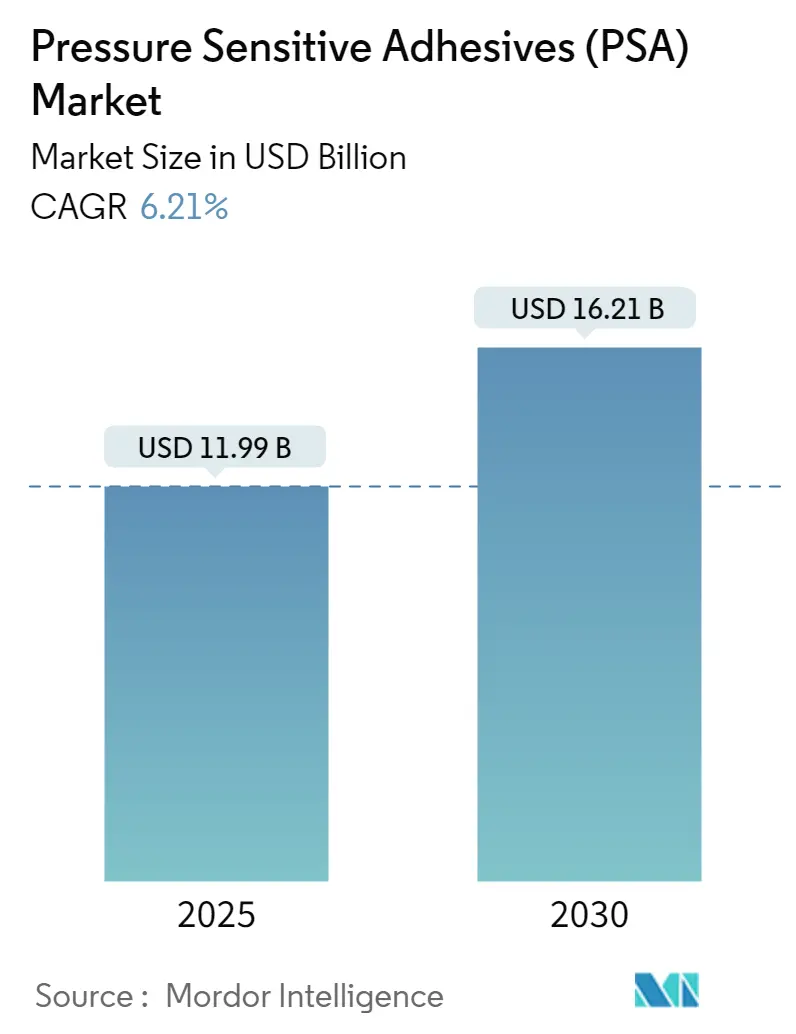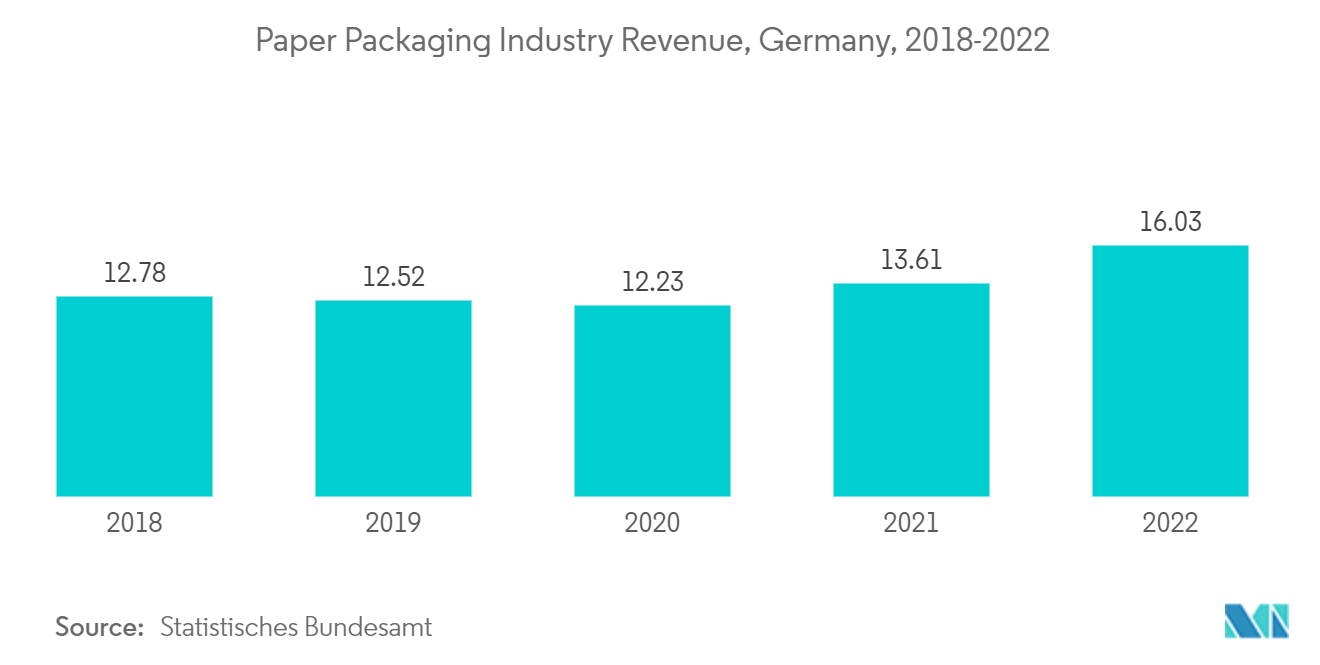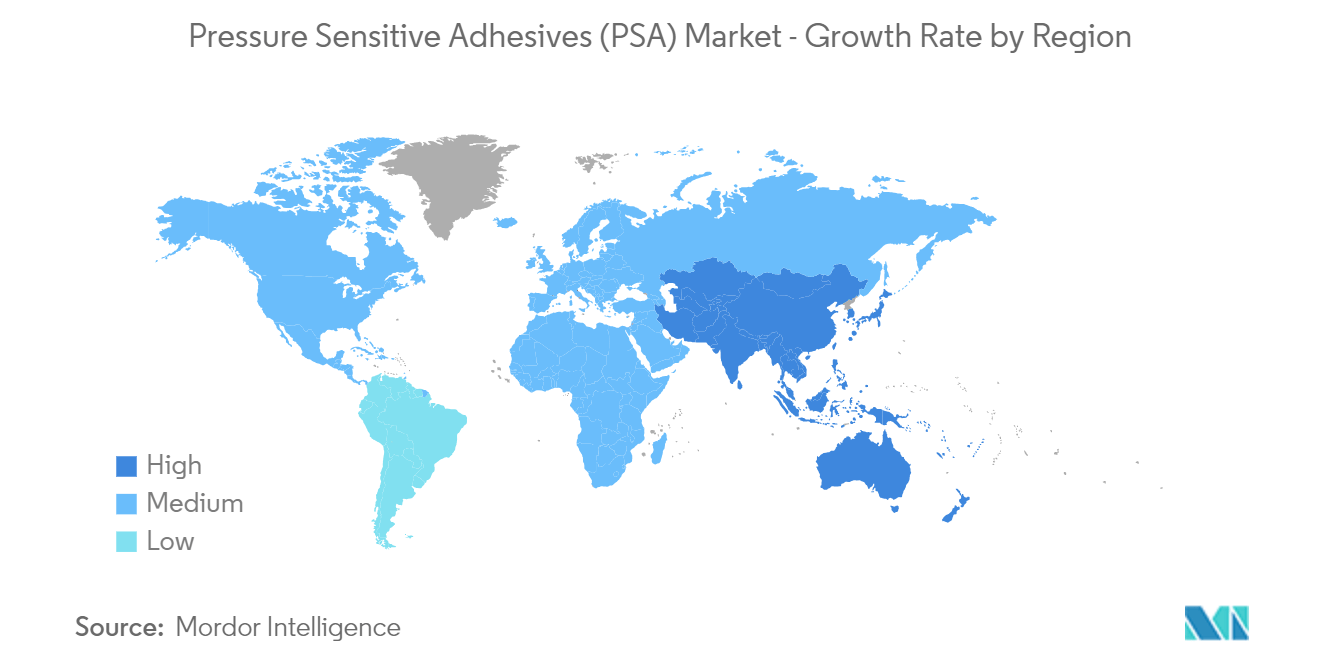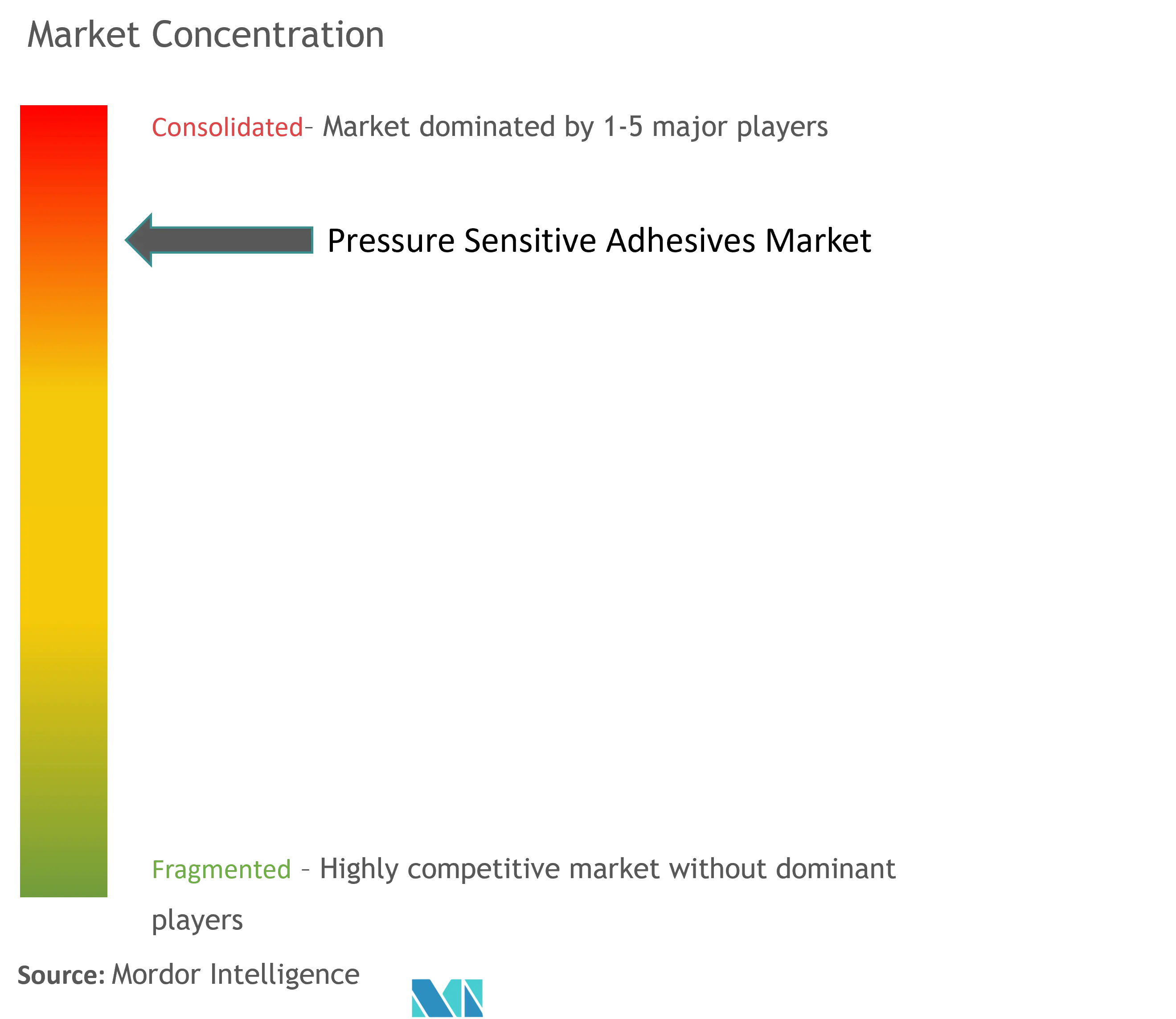
Pressure Sensitive Adhesives (PSA) Market Analysis by Mordor Intelligence
The Pressure Sensitive Adhesives Market size is estimated at USD 11.99 billion in 2025, and is expected to reach USD 16.21 billion by 2030, at a CAGR of 6.21% during the forecast period (2025-2030).
Due to the COVID-19 outbreak, nationwide lockdowns worldwide, disruption in manufacturing activities and supply chains, and production halts negatively impacted the market in 2020. However, the conditions started recovering in 2021, restoring the market's growth trajectory.
- The major factor driving the market studied is the increasing development of low-cost, flexible packaging and increasing usage of pressure-sensitive adhesives because of lesser curing time.
- On the flip side, stringent environmental regulations regarding VOC emissions and increasing usage of substitutes like UV-cured adhesives are expected to hinder the studied market's growth.
- The tapes segment dominated the market and is expected to grow during the forecast period. It is owing to the growing end-user industries, such as packaging, medical, and transportation.
- Adopting bio-based pressure-sensitive adhesives and developing nanotechnology-based functional pressure-sensitive adhesives is likely an opportunity in the future.
- Asia-Pacific dominated the global market, with the largest consumption from countries such as China and India.
Global Pressure Sensitive Adhesives (PSA) Market Trends and Insights
Packaging Industry to Dominate the Market
- Adhesives ensure the product packaging remains intact until it reaches the consumer. Packaging operations require a reliable adhesive to meet the increasingly complex packaging demands as there is an increase in several new products and product proliferation.
- Pressure-sensitive adhesives (PSAs) specifically offer several advantages for the packaging industry:
- Quick reworks: Reworking or repackaging increases costs. PSAs offer a timely way to make products compliant and shelf-ready. Pressure-sensitive adhesives are safer than glue sticks and more discrete than traditional tape. Unlike glue sticks, pressure-sensitive adhesives do not require heat during application. The absence of heat eliminates burns and increases safety among plant workers. Additionally, PSAs are less intrusive on packaging graphics, providing the required adhesion without sacrificing the brand image. Pressure-sensitive adhesives are less visible packaging solutions that preserve and maximize the brand's impact.
- Instant bond: Applying pressure-sensitive adhesives is time-saving, as waiting until they cure is unnecessary. When applied, they compress the substrate right when adhesion occurs. Instant bonding increases the processing speed, as well as improves production.
- Maintaining brand image: Brand image relies heavily on the packaging appearance. PSAs provide a bond that removes cleanly without damaging the packaging or leaving behind residue. Preserving brand image adds to your consumer appeal.
- Furthermore, in the last few years, the packaging industry is experiencing a transition where the manufacturing and industrial sector is adapting to flexible packaging.
- The benefits, such as being lightweight, easy to handle, less space-consuming, longer shelf life, easy transit, damage resistance, and better printability, made packaging popular.
- With the growing trend of e-commerce, e-retail, and online food orders and delivery services, the demand for packaging materials, especially flexible packaging, is increasing, likely to drive the demand for UV-curable adhesives during the forecast period. In Germany, the paper packaging industry grew significantly in 2022 compared to previous years.
- According to the Packaging Industry Association of India (PIAI), the Indian packaging industry is expected to grow at 22% during the forecast period. Moreover, the Indian packaging market is expected to reach USD 204.81 billion by 2025.
- Flexible packaging is used in food packaging applications in low-income South America, Africa, and Asia-Pacific countries. The popularity and demand for flexible packaging are rising in emerging economies, and the demand is supported by continued economic expansion and an acceleration in the food and beverage industry.
- The paper packaging industry grew significantly in Germany in 2022 because of the increasing demand for non-fossil-based packaging for different end-user industries.
- Such factors will likely increase the demand for the pressure-sensitive adhesives market over the forecast period.

Asia-Pacific Region is Expected to Dominate the Market
- With over 40% of the global demand, Asia-Pacific is the most promising market for pressure-sensitive adhesives, which will likely dominate soon. This domination can be attributed to the region's growing demand for tapes and labels.
- China, India, Japan, and South Korea account for over 80% of the demand for pressure-sensitive adhesives.
- China is one of the major exporters of adhesive products (tapes, labels, etc.). The factors concerning most of its customers are the product quality, the product range offered by the vendor, and reducing the dosage and wastage of adhesives. Therefore, international players currently dominate the Chinese market for pressure-sensitive adhesives. The same factor encourages local producers to invest in R&D to acquire a major national market share.
- China is the world's largest packaging consumer globally, owing to growing per capita income and rising e-commerce giants. India's packaging industry is the fifth-largest globally, growing at about 22-25% per year, according to the Plastics Industry Association of India. Packaging and processing food costs can be 40% lower than in Europe because of highly skilled labor and cheap labor costs. The growing population and increasing demand for packaging are expected to drive the market.
- Furthermore, the Chinese packaging industry grew rapidly and consistently in recent years, owing to the expanding economy and rising middle class with greater purchasing power. Food packaging is a major player in the packaging industry, accounting for roughly 60% of the total market share in China. According to Interpak, in China, in the foodstuff packaging category, total packaging is expected to reach 447 billion units in 2023, indicating an increased demand for pressure-sensitive adhesives from the packaging industry.
- The pressure-sensitive adhesives market in India is expected to grow at a higher rate. Its usage increased with transparent and film labels, shrink-wrap labels for fast-moving consumer goods (FMCG) manufacturers, flexible labels, and multicolor wrap-around labels. The pressure-sensitive adhesives market is still in its early growth stage, with a higher scope of growth in the future.
- The large market size, coupled with the huge growth of Asia-Pacific, is instrumental in expanding the pressure-sensitive adhesives market.

Competitive Landscape
The pressure-sensitive adhesives market is consolidated. The top seven players account for almost 60%. The major companies (not in any particular order) include 3M, Arkema, DuPont, HB Fuller, and Henkel AG & Co. KGaA.
Pressure Sensitive Adhesives (PSA) Industry Leaders
3M
Arkema
DuPont
HB Fuller
Henkel AG & Co. KGaA
- *Disclaimer: Major Players sorted in no particular order

Recent Industry Developments
- February 2023: Arkema launched pressure-sensitive adhesives solutions, including all of the predominant technologies in the industry, such as hot melt, waterborne, UV, and specialty solution acrylics.
Global Pressure Sensitive Adhesives (PSA) Market Report Scope
Pressure-sensitive adhesives are types of adhesives that can be cured upon application of pressure. In pressure, the adhesives get solid and bond to the substrates required. The pressure-sensitive adhesives market is segmented by technology, resin, application, end-user industry, and geography. The market is segmented by technology into waterborne, solvent-borne, hot melt, and radiation cured. The market is segmented by resin type into silicone, acrylic, elastomer, and other resin types. The market is segmented by application into tapes, labels, graphics, and other applications. By end-user industry, the market is segmented into packaging, woodworking and joinery, medical, commercial graphics, transportation, electronics, and other end-user industries. The report also covers the market size and forecasts for the pressure-sensitive adhesives market in 15 countries across major regions. The report offers market size and forecasts for the pressure-sensitive adhesives market in revenue (USD) for all the above segments.
| Water-based |
| Solvent-based |
| Hot Melt |
| Radiation |
| Acrylics |
| Silicones |
| Elastomers |
| Other Resins |
| Tapes |
| Labels |
| Graphics |
| Other Applications |
| Packaging |
| Woodworking and Joinery |
| Medical |
| Commercial Graphics |
| Transportation |
| Electronics |
| Other End-user Industries |
| Asia-Pacific | China |
| India | |
| Japan | |
| South Korea | |
| Rest of Asia-Pacific | |
| North America | United States |
| Canada | |
| Mexico | |
| Europe | Germany |
| United Kingdom | |
| Italy | |
| France | |
| Rest of Europe | |
| South America | Brazil |
| Argentina | |
| Rest of South America | |
| Middle-East and Africa | Saudi Arabia |
| South Africa | |
| Rest of Middle-East and Africa |
| Technology | Water-based | |
| Solvent-based | ||
| Hot Melt | ||
| Radiation | ||
| Resin | Acrylics | |
| Silicones | ||
| Elastomers | ||
| Other Resins | ||
| Application | Tapes | |
| Labels | ||
| Graphics | ||
| Other Applications | ||
| End-user Industry | Packaging | |
| Woodworking and Joinery | ||
| Medical | ||
| Commercial Graphics | ||
| Transportation | ||
| Electronics | ||
| Other End-user Industries | ||
| Geography | Asia-Pacific | China |
| India | ||
| Japan | ||
| South Korea | ||
| Rest of Asia-Pacific | ||
| North America | United States | |
| Canada | ||
| Mexico | ||
| Europe | Germany | |
| United Kingdom | ||
| Italy | ||
| France | ||
| Rest of Europe | ||
| South America | Brazil | |
| Argentina | ||
| Rest of South America | ||
| Middle-East and Africa | Saudi Arabia | |
| South Africa | ||
| Rest of Middle-East and Africa | ||
Key Questions Answered in the Report
How big is the Pressure Sensitive Adhesives Market?
The Pressure Sensitive Adhesives Market size is expected to reach USD 11.99 billion in 2025 and grow at a CAGR of 6.21% to reach USD 16.21 billion by 2030.
What is the current Pressure Sensitive Adhesives Market size?
In 2025, the Pressure Sensitive Adhesives Market size is expected to reach USD 11.99 billion.
Who are the key players in Pressure Sensitive Adhesives Market?
3M, Arkema, DuPont, HB Fuller and Henkel AG & Co. KGaA are the major companies operating in the Pressure Sensitive Adhesives Market.
Which is the fastest growing region in Pressure Sensitive Adhesives Market?
Asia Pacific is estimated to grow at the highest CAGR over the forecast period (2025-2030).
Which region has the biggest share in Pressure Sensitive Adhesives Market?
In 2025, the Asia Pacific accounts for the largest market share in Pressure Sensitive Adhesives Market.
What years does this Pressure Sensitive Adhesives Market cover, and what was the market size in 2024?
In 2024, the Pressure Sensitive Adhesives Market size was estimated at USD 11.25 billion. The report covers the Pressure Sensitive Adhesives Market historical market size for years: 2019, 2020, 2021, 2022, 2023 and 2024. The report also forecasts the Pressure Sensitive Adhesives Market size for years: 2025, 2026, 2027, 2028, 2029 and 2030.
Page last updated on:
Pressure Sensitive Adhesives (PSA) Market Report
The Global Pressure Sensitive Adhesives (PSA) Market is segmented by technology, resin, application, end-user industry, and geography. The market analysis includes a comprehensive industry overview and market forecast, providing insights into market trends, industry statistics, and market segmentation. The industry reports highlight the market growth and market size, offering a detailed market review and market outlook for the PSA market.
The industry research indicates that the PSA market is poised for significant growth, driven by various end-user industries such as packaging, woodworking and joinery, medical, commercial graphics, transportation, and electronics. The market data and industry information suggest that the PSA market will see substantial market value and industry sales in the coming years.
The report example provides a report PDF download for further industry analysis and market predictions. The industry research covers the market leaders and their strategies to maintain market share and market growth. The industry outlook and market overview are essential for understanding the market dynamics and future market trends.
Overall, this industry report serves as a crucial resource for research companies and stakeholders interested in the PSA market, providing detailed insights into market size, market forecast, and market segmentation. The report also includes industry trends and market data to help understand the market value and market growth rate.


